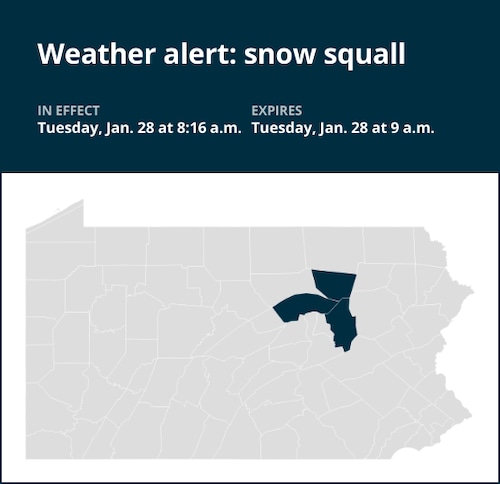At 8:16 a.m. on Tuesday, the National Weather Service reported a snow squall through 9 a.m. for Southern Lycoming, Sullivan, and Columbia counties.
“At 8:14 a.m., a snow squall was along a line extending from 18 miles south of Wyalusing to 16 miles northeast of Montoursville and moving south at 25 MPH,” according to the weather service.
Berwick, Lightstreet, Lairdsville, Biggertown, Muncy Valley, Millville, Benton, Stillwater, and Eagles Mere are among the places affected by the alert. The following highways are included in this: From Glen Mawr, take Route 220 south of Laporte. West of Red Rock, on State Road 118 from Lairdsvile.
The weather service states that “in winter weather conditions, conditions can deteriorate rapidly.” Be ready for roads covered with ice or snow. To get to your destination, slow down and give yourself more time.
Snow squalls: Safety protocols and prevention tips
What are snow squalls?
Strong cold fronts are frequently linked to snow squalls, which are severe winter weather conditions. Even in the absence of a significant winter storm, they can swiftly cover roads with snow and ice. Even while these squalls usually last less than an hour and only produce light snow accumulation, their restricted visibility, strong winds, and quickly falling temperatures can make them dangerous. Unfortunately, in the past, these circumstances have played a role in catastrophic and occasionally fatal road accidents.
What is the difference between a snow squall and a snowstorm?
A snowstorm and a snow squall differ primarily in their strength and length. Usually lasting 30 to 60 minutes, snow squalls are short yet fierce. A snowstorm, on the other hand, can last for several hours or even days.
Snow squall warnings
Similar to tornado and severe thunderstorm warnings, snow squall alerts are short-fused and targeted at specific locations. These alerts offer vital, extremely targeted information that can save lives. If your neighborhood is under a snow squall warning, stay indoors or postpone driving until the squall has passed.
Actions during a snow squall warning
When a snow squall warning is issued, people should heed the weather service’s instructions, which include the following crucial steps:
Avoid or postpone travel: It is best to wait until the snow squall has gone through your area before driving if a snow squall warning has been issued for your area. During snow squalls, roadways and highways are especially dangerous.
Reduce speed and improve visibility: If you’re already on the road during a snowstorm, put safety first by slowing down. To improve visibility for other vehicles and yourself, turn on your danger lights in addition to your headlights.
Keep a safe distance: Make sure there is enough space between your car and the one in front of you. In order to account for decreased vision and the possibility of unpredictable road conditions during a squall, this precaution is crucial.
Steer clear of sudden braking: It’s also best to avoid applying the brakes too hard. This could lead to a loss of vehicle control and raise the possibility of a chain reaction collision on slick or icy roads.
Winter weather safety advice: Go to the weather service’s Winter Weather Safety page for advice on how to be safe before, during, and after a winter storm.
Make sure your car is ready for winter driving by checking the tires, brakes, lights, and making sure all the fluids are at the right levels before you go. A well-maintained car is better equipped to handle the challenges of winter driving.
Essentials of an emergency kit: Make sure your car has a complete emergency kit that includes supplies like water, non-perishable food, blankets, a flashlight, and a first aid kit. To improve tire traction, don’t forget to have jumper cables, flares or a reflective triangle, ice scraper, a map, a car cell phone charger, and cat litter or sand. In the event of an emergency or unplanned breakdown while traveling, these provisions may prove to be quite beneficial.
In conclusion, putting one’s own safety first and following the weather service’s advice can greatly reduce dangers when a snow squall warning is in effect. People can travel through these winter dangers with more assurance and security if they are aware of them, plan beforehand, and remain alert.
United Robots offers a service called Advance Local Weather Alerts that gathers the most recent information from the National Weather Service using machine learning.

